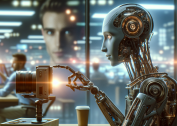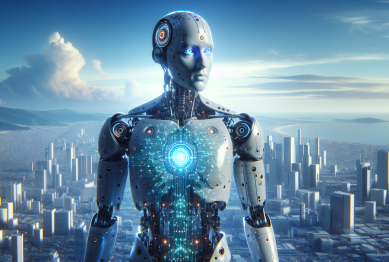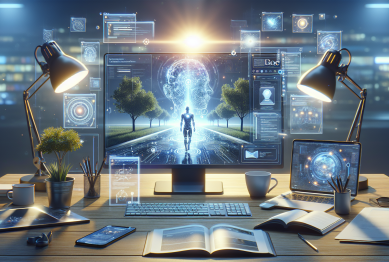Artificial intelligence now shapes more daily experiences than most realize. From virtual assistants to social media feeds, AI alters routines, work, and the way you connect. Explore its unexpected roles and see how these innovations quietly power modern life behind the scenes.
The Invisible AI Building Blocks All Around
Artificial intelligence is far from science fiction—it’s woven into the fabric of society. Most people interact with AI systems every day, even if they don’t notice. For example, search engines use AI algorithms to rank millions of web pages, surfacing the most relevant ones instantly. This same logic hints at products online, personalizes news, and optimizes ads. Automated chatbots now answer basic service questions, quickly resolving issues that once took hours. These building blocks are based on machine learning, a field where computers “learn” patterns from massive sets of data. When you unlock your smartphone with your face, that’s AI in action. Image recognition, speech processing, and fraud detection all rely on this technology. Most modern devices have AI running quietly in the background, managing processes, anticipating preferences, and protecting data. The reach of AI is often most powerful when it’s least obvious, seamlessly blending with routine activities without a second thought.
Consider the smart assistants in homes today—devices like Alexa, Google Assistant, and Siri. These helpers transform spoken words into text, interpret questions, and provide answers or control your environment. They learn voice nuances and adapt to give smarter responses. In web browsing, AI suggests articles, recommends videos, and filters out spam. This is possible with natural language processing, a technology tuned to understand context, irony, and intent. When you type a search query, AI predicts how to finish it. As you scroll social feeds, algorithms pick friends’ posts and ads tailored to individual tastes. These silent systems stay active all the time, working to enhance user experiences. It’s not just flashy gadgets; AI influences everything from home appliances that adjust temperatures to cars that warn of traffic hazards. The more advanced the tools get, the more invisible they’ve become to most.
Even banking now depends on AI technologies. Whenever transactions look suspicious, banks deploy machine learning to spot potential fraud. Unusual withdrawals or purchases trigger alerts and automatic holds. AI helps process loans, weighing credit, collateral, and behavior to make complex decisions faster. Meanwhile, retailers deploy recommendation engines that keep track of shopping history to personalize products and offer more relevant discounts and bundles. Behind the scenes, these advanced algorithms can aggregate, analyze, and act on data far faster than any human. This enables real-time fraud prevention, smarter logistics, and enhanced customer satisfaction. At the end of the day, artificial intelligence is the silent force giving smarter, safer, and more responsive services across all types of industries.
How AI Personalizes Everyday Experiences
Personalization has become a buzzword across technology, and AI makes it truly possible. Every scroll, click, and like sends signals to algorithms, which “learn” user habits and preferences. Music platforms like Spotify and Apple Music employ neural networks to suggest tracks with uncanny accuracy. The more one listens, the better these platforms predict the next favorite song—sometimes before even realizing a preference. AI forms playlists based on mood, recent history, and listening time. The shopping world also leverages personalization by tracking purchase data to promote items people are more likely to buy. This tailored approach helps users save time and discover new favorites, building a sense of seamless discovery rather than endless searching.
Streaming video platforms are perhaps one of the most recognizable examples of AI-driven personalization. Netflix, Hulu, and YouTube use detailed viewing history, search patterns, and even how long you hover over a thumbnail. Their AI analyzes character preferences, genres, and even time of day. The result is movie and show recommendations that feel eerily accurate. These platforms rely on collaborative filtering and content-based algorithms, showing different viewers entirely unique options. It goes beyond entertainment—news apps curate headlines based on interests, app usage, and engagement. Even online advertisements reflect AI’s personalization power, appearing based on recent searches, locations, or trending topics among peer groups. The underlying goal is to deliver connection and value.
AI’s personalization benefits extend to health and wellness too. Activity trackers and smartwatches use intelligent algorithms to analyze heart rates, sleep quality, and activity patterns. They suggest optimal routines, flag irregularities, and encourage movement. Some digital coaches offer tailored advice for nutrition or fitness goals. In education, learning platforms adapt lesson difficulty based on student progress. These systems predict struggling points before learners do, ensuring help comes right when it’s needed. Such AI-enhanced personalization improves engagement and optimizes the likelihood of reaching milestones. Every digital journey becomes a little more unique, reflecting who someone is and, increasingly, who they could be.
Spotlight on Virtual Assistants and Automation
Virtual assistants stand at the frontlines of consumer artificial intelligence. Devices such as Amazon Echo, Google Nest Hub, and Apple HomePod have evolved beyond executing simple commands to managing entire digital ecosystems. These assistants integrate with other smart technologies, like thermostats and lights, to create personalized environments. Automation allows tasks such as setting daily alarms, organizing calendars, and reordering groceries with just a single phrase. Behind the scenes, these assistants rely on deep learning architectures, drawing from vast databases to process natural language and learn individual habits. The more a user interacts, the smarter the assistant becomes, offering prompts or reminders before being asked. Such automation has transformed routines, making everyday living more convenient, especially for those with busy schedules or accessibility needs.
Workplaces are also being reimagined by automation and AI-based scheduling. Chatbots handle meeting bookings, reminders, and even customer communications at scale. Email filtering, spam detection, and quick response templates are powered by predictive algorithms. Many industries now use robotic process automation to handle repetitive back-office functions, freeing employees to focus on higher-value tasks. For example, financial services use AI bots to automatically reconcile accounts and detect reporting discrepancies. In healthcare, automated appointment reminders and record updates cut down on manual errors and waiting time. These quiet improvements boost productivity and reduce human error, opening new possibilities for business growth and employee satisfaction.
At home, advances in AI-driven automation are creating safer and more energy-efficient spaces. Smart security systems analyze footage for unusual patterns, alerting homeowners or authorities if needed. Automated lighting systems learn occupancy patterns and adjust for energy savings. Refrigerators and appliances can alert when supplies run low or suggest recipes based on what’s left inside. AI’s predictive maintenance capabilities in connected devices minimize costly breakdowns. These applications rarely draw attention, but their collective impact creates more secure, sustainable, and comfortable homes. Automation, driven by virtual assistants and machine learning, is redefining convenience, safety, and overall quality of life, step by step.
AI in Healthcare: Subtle Enhancements to Patient Wellbeing
The healthcare sector is experiencing a gradual but fundamental transformation owing to artificial intelligence and its data analysis powers. AI-driven diagnostic tools can sift through thousands of medical images in seconds, identifying early signs of diseases like cancer more reliably and efficiently. Algorithms trained to flag anomalies boost accuracy for radiologists and reduce the chance of missed details. In hospitals, AI helps optimize bed usage, predict patient surges, and streamline supply chains so critical items are always available. Wearable health devices use smart sensors and AI-driven insights to monitor vitals and alert healthcare professionals if metrics look risky. These advances make care more precise, proactive, and patient-centered—without ever replacing the human touch.
Beyond diagnostics, AI supports personalized treatment plans by processing vast troves of patient data. Machine learning algorithms compare thousands of cases to suggest optimal drug dosages, anticipate side effects, and recommend therapy adjustments in real time. Such personalized medicine improves outcomes for patients with chronic conditions or rare diseases. Natural language processing allows healthcare workers to document notes by voice, freeing up time for the human aspects of care. Even hospital scheduling is being optimized with algorithms that balance staff workloads and prioritize urgent needs. The results are shorter wait times, fewer errors, and more efficient operations—all quietly powered by background AI processes.
Telehealth is another area benefiting from AI advances. Intelligent virtual assistants and chatbots triage basic medical queries, help patients find specialists, or connect users to appropriate resources. During public health emergencies, AI-powered tools analyze patterns in global data to flag outbreaks sooner and suggest targeted interventions. This predictive capability stems from the system’s ability to process data at speeds impossible for humans. Healthcare journeys are becoming more streamlined, responsive, and accessible, thanks in large part to innovations that remain invisible to patients. It is this subtle but profound influence that positions AI as an indispensable partner in the evolution of modern healthcare.
Addressing Challenges and Responsible AI Use
With all the positive changes, AI’s rise brings new concerns and responsibilities. Transparency in algorithm decision-making is a growing demand. Many users worry about personal data privacy and how much AI knows or shares with third parties. The technology’s ability to learn from sensitive health, financial, or browsing information must be protected with robust cybersecurity measures. Regulatory bodies such as the European Union and several US agencies set guidelines for responsible AI deployment, emphasizing privacy, ethics, and security. Building trust requires not just secure systems but also open communication about how data is used and what choices people can make regarding their information. Ongoing education ensures that the public can benefit from AI while understanding its limits and risks.
Bias in algorithms is another challenge. Since AI learns from human-generated data, it can adopt biases present in that data, leading to unfair or unbalanced recommendations. Examples include hiring tools favoring certain backgrounds or facial detection systems performing unequally across demographic groups. Addressing this calls for rigorous testing, regular auditing of AI outputs, and greater diversity in development teams. Some organizations actively pursue explainable AI initiatives—methods to clarify how systems reach decisions so that users and regulators can understand logic and intent. Opportunities for public input and oversight are expanding, ensuring that AI improves, rather than entrenches, social equity.
Finally, the long-term impact of AI on jobs sparks both excitement and unease. Automation can make life easier, but it may also disrupt traditional roles. Emphasis on upskilling and education helps people adapt to new career landscapes where AI complements, rather than replaces, human creativity and empathy. Many experts believe ongoing partnerships between humans and machines will elevate productivity, safety, and opportunity. Transparent practices and open dialogue with stakeholders ensure secure and equitable use of artificial intelligence. By addressing challenges with care, society can unlock the possibilities of AI while protecting privacy, security, and fairness for all.
References
1. European Commission. (n.d.). Ethics guidelines for trustworthy AI. Retrieved from https://digital-strategy.ec.europa.eu/en/library/ethics-guidelines-trustworthy-ai
2. National Institute of Standards and Technology. (n.d.). AI risk management framework. Retrieved from https://www.nist.gov/itl/ai-risk-management-framework
3. U.S. Food & Drug Administration. (n.d.). Artificial Intelligence and Machine Learning in Software as a Medical Device. Retrieved from https://www.fda.gov/medical-devices/software-medical-device-samd/artificial-intelligence-and-machine-learning-software-medical-device
4. Stanford University Human-Centered AI. (2021). AI Index Report. Retrieved from https://aiindex.stanford.edu/report/
5. MIT Sloan. (2020). The state of AI in 2020. Retrieved from https://mitsloan.mit.edu/ideas-made-to-matter/state-ai-2020
6. Pew Research Center. (2022). Experts Say the ‘New Normal’ in 2025 Will Be Far More Tech-Driven. Retrieved from https://www.pewresearch.org/internet/2021/02/18/experts-say-the-new-normal-in-2025-will-be-far-more-tech-driven/









